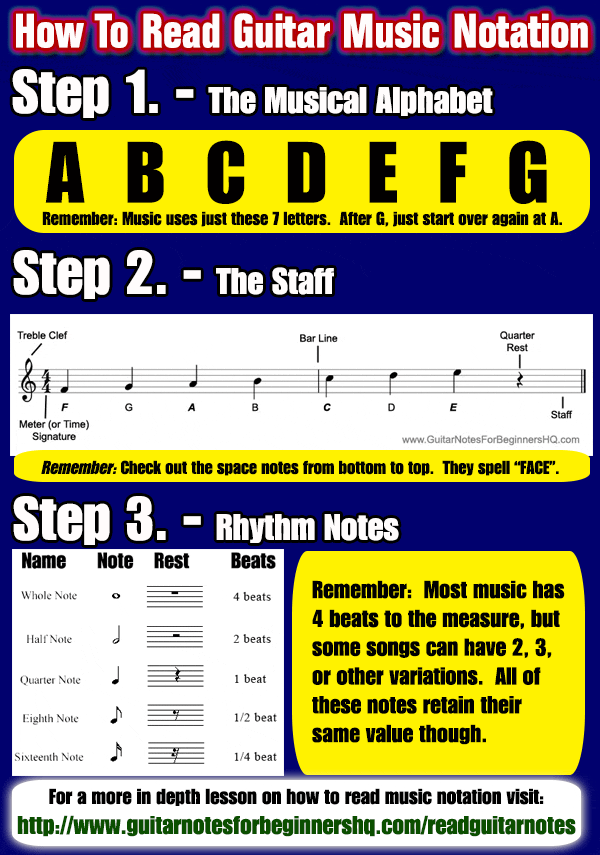Among many of my new students, the biggest fear is learning to read music notation. Learning how to read guitar notes is much easier than everyone makes it out to be. There’s two things I want you to remember here:
 1. Music notation is just the instructions on how to play the song. The goal here isn’t the reading. It’s playing the song.
1. Music notation is just the instructions on how to play the song. The goal here isn’t the reading. It’s playing the song.
2. Way back when you learned how to read books in the second grade, you started simple and did it consistently to get good at it. Learning to read music notation is exactly the same thing. Start simple and do it consistently. You’ll get good at it quickly.
Every note has a letter name from the musical alphabet. Our musical alphabet is just the first 7 letters of the regular alphabet, A through G. Now, obviously, the guitar has lots more than 7 notes. So when we get to G, we simply start over again at A and repeat.
Let’s look at how these notes get placed on the page and some of the common music notation terms we use.
Here’s a quick vocabulary list:
Staff – The set of five lines that all of our other markings are placed on.
Treble Clef – Also sometimes called a “G Clef”, it’s the swirly looking thing at the beginning of each line. On guitar that’s really all you need to know about it. There are other clefs, but the guitar doesn’t use any of them.
Bar Line – Bar lines divide up a line of music into segments called measures. They’re only there to make it easier visually to keep track of where you are in the music. Bar lines don’t affect the music otherwise.
Meter (or Time) Signature – You’ll see one of these at the beginning of each piece. It gives you two pieces of information. The top number tells you how many beats are in each measure. If it’s a 4 you’re counting 1-2-3-4. If it’s a 3 you’ll count 1-2-3. The top number can have a lot of different values, but 2, 3, and 4 are the most common.
Now, most of those terms you’ll never have to think about again. You’ll just know they’re always there.
Let’s look at the notes now. You’ll see in the graphic that notes are placed on the lines and spaces of the staff. Start by just looking at the space notes from the bottom up. F – A – C – E which spells…. “face”. So if you can remember how to spell “face”, you can remember the space notes from bottom to top very easily.
Quick Side Note:
You’ll see me talk a lot about “systems” rather than “memorizing” in my articles. Our brains don’t work well at memorizing things. There’s actually a limit of about 7 things we can memorize in order before we start to forget. Instead we want to have one or two small memorization points and then a system to figure out everything else we need to know. If you attack reading music with my system you’ll learn it much faster. Eventually your brain goes through the system enough time that it appears that you’ve memorized the technique. In fact, it’s just your brain going through the system so fast you don’t perceive it anymore.
You can jump into playing guitar quickly with The 30-Day Guitar Challenge.
 So here, the only thing we’re memorizing is “FACE”. Easy right? Now you can easily figure out the line notes by finding the letter that come in between. In between A and C is B. So B sits on the line between A and C on the staff. Look at the music notation picture again and you’ll see how those line notes work out.
So here, the only thing we’re memorizing is “FACE”. Easy right? Now you can easily figure out the line notes by finding the letter that come in between. In between A and C is B. So B sits on the line between A and C on the staff. Look at the music notation picture again and you’ll see how those line notes work out.
When we run out of room on the staff you’ll start to see the notes go into “ledger lines” both above and below the staff. Just continue your musical alphabet forwards if you’re going above the staff or backwards if you’re going below. Count your way through each line and space alphabetically to find the note you’re on.
Action Step: Here’s how you can practice this. Open up any piece of sheet music and start reading off the note names. If you use the tools I’ve given you here, you can read any note that’s put in front of you. See if you can read off all the notes for a piece that’s maybe a page long. Then go back and take just one line. Read the notes on that line 5 times, seeing if you can do it faster each time. You can even time yourself to see your progress.
In the next article you’ll learn how to read music notation rhythms. Stay tuned!
I’ve included a cheat sheet graphic that you can use as a shortcut for learning this stuff. Pin it to your Pinterest account so you can refer to it later!

Get my guide to the “12 Parts of Playing Guitar You Need To Know” plus “The Perfect Practice Session” by sending out a quick tweet with the Tweet2Download button below.
12GuitarThingsPerfectPrac ..
Want to get started fast, learn 3 whole songs in 30 days, and easily get in the habit of playing your guitar every day? Jump into The 30-Day Guitar Challenge.

Thank You from a 47 yr old man who just started learning the guitar and just for the some reason could not read the notes or place them so i started to write it as A B C D… And now u have come like a light and broke the spell and made it so easy.
So a big thank you and God bless.
From Down Under Australia (Melbourne)
I’m so glad Sinclair! Keep on going!
thanks